Interesting Science Videos
Stem Cells Definition
Stem cells are unique cells present in the body that have the potential to differentiate into various cell types or divide indefinitely to produce other stem cells.
- Stem cells are essential cells that replace damaged cells or cells lost due to diseases.
- These cells are the earliest cells of the cell lineage in all tissues and are found in both embryonic and adult organisms.
- These cells provide a continuous supply of new cells that make up the tissues and organs of animals and plants.
- Stem cells have been of great interest as a therapeutic method for various diseases and conditions.
- The stem cells in the embryonic organism are present in the inner cell mass of the blastocyte, which then differentiates into all other cells in the body.
- The stem cells in adults, however, are localized to specific areas within the body like in the bone marrow and the gonads.
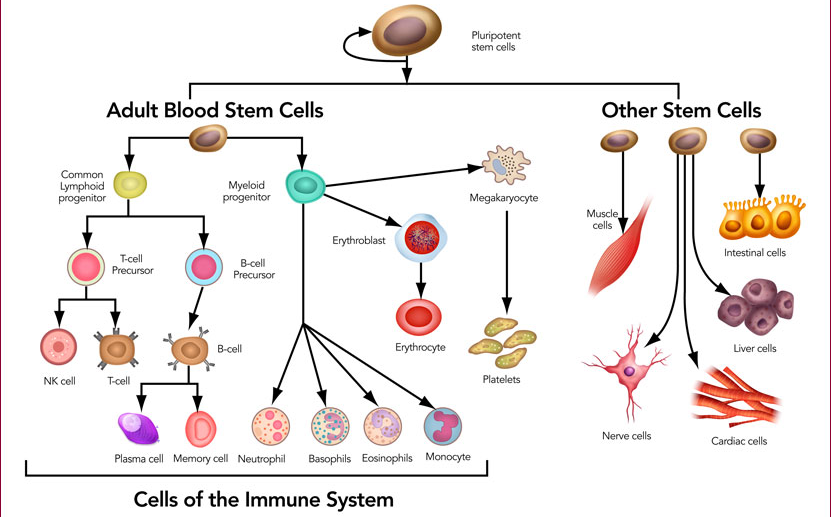
Figure: Stem Cell Renewal and Differentiation. Image Source: Maharaj Institute of Immune Regenerative Medicine.
Properties of Stem Cells
All the stem cells found throughout all living systems have three important properties. These properties can be visualized in vitro by a process called clonogenic assays, where a single cell is assessed for its ability to differentiate.
The following are some properties of stem cells:
- Stem cells, of all origins, are capable of dividing and renewing themselves for long periods of time. These cells undergo a period of cell proliferation while preserving the undifferentiated state.
- All stem cells are unspecialized or undifferentiated. These are present as a mass of cells that differentiate later during their period of division.
- Another essential property of stem cells is their ability to differentiate into specialized cells that together make up different tissue types. These cells can be either pluripotent or multipotent.
Stem Cell Culture
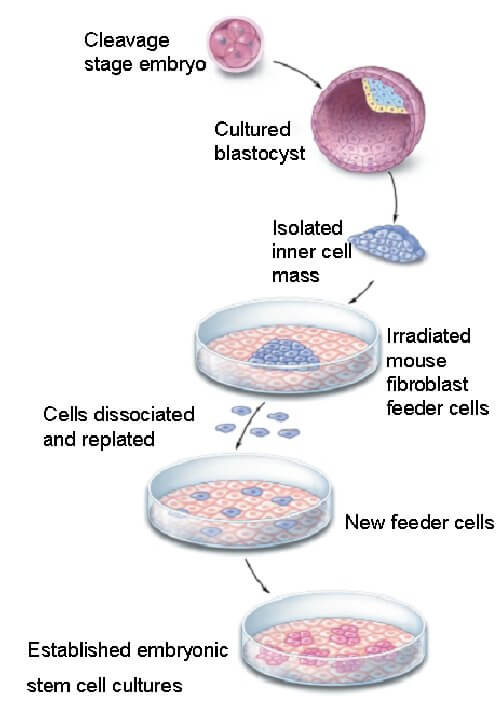
Figure: Techniques for generating embryonic stem cell cultures. Image Source: John Wiley & Sons, Inc. (Nico Heins et al.)
- There is increasing interest in optimizing stem cell culture, not only because cell culture is widely used in basic research for studying stem cell biology, but also owing to the potential therapeutic applications of cultured stem cells.
- Because of their ability to replace damaged cells, these cells are cultured under artificial conditions to produce more of these cells.
- Embryonic stem cells are more potent than adult stem cells as they are capable of differentiating into various cell types.
- Adult stem cells, however, are less potent and more restricted as they can only differentiate into specific lineages.
- Because of this reason, embryonic stem cells are mostly cultured to obtain more embryonic stem cells.
- Stem cell culture conditions must be refined according to the stem cell type, e.g. cell culture requirements for embryonic stem cells (ES) or different kinds of adult stem cells may not be the same.
- Similarly, cell culture parameters need to be refined according to the ultimate purpose of the stem cell culture.
- The process of stem cell culture should be refined throughout the process as stem cells always balance between self-renewal and differentiation.
- The culture of stem cells might be different from that of other cells as some stem cells require non-standard cell culture reagents, such as feeder cell layers, conditioned media, or growth matrices.
- Different media and conditions are to be employed, considering the purpose of the culture where some cultures might be done to keep the cells in their stem-state while others might want the cells to be differentiated.
- During culture, cells are usually passaged under a laminar flow hood and maintained in incubators which are under atmospheric partial oxygen pressure.
- A major challenge in cell culture is the control and the maintenance of well-defined cell culture conditions, especially the pH and oxygen pressure.
Video: What are stem cells? – Craig A. Kohn by TED-Ed.

Types/ Sources of Stem Cells
Depending on the source of the stem cells or where they are present, stem cells are divided into various types;
1. Embryonic stem cells
- Embryonic stem cells are a group of cells that are present in the inner cell mass of the embryo at a very early stage of development, called a blastocyst.
- The blastocyst stage in embryonic development is reached within 4-5 days after fertilization, and the number of cells at that point is about 50-150.
- These cells are pluripotent, meaning they can develop and differentiate into various cell types (approx 250 types) during their proliferation. These do not, however, contribute to the extraembryonic cells like the placenta.
- Embryonic stem cells are present within the embryo, which divides and differentiates into germ layers as they become specialized.
- These cells have been culture increasingly as they can be artificially cultured to produce cells of different types.
- Embryonic stem cell culture is important as they perform as a new source for regenerative medicine and genetic disease and toxicology test in vitro.
- The embryonic germ cells in the gonadal region in animals also act like embryonic stem cells. These cells, also called primordial cells, later differentiate and divide to form male and female gametes.
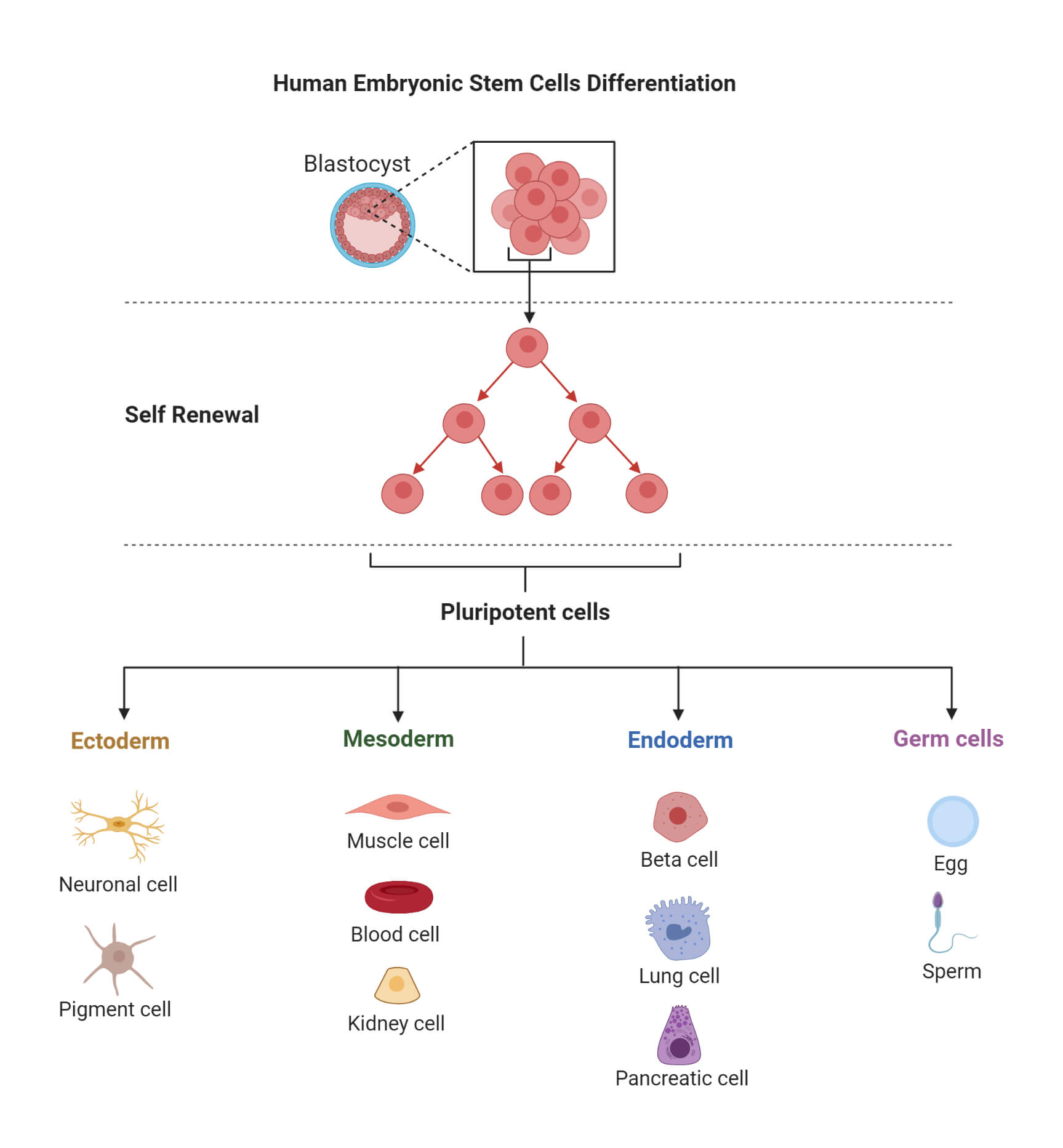
Figure: Human Embryonic Stem Cells Differentiation. Image created with biorender.com
2. Adult stem cells (Somatic or Tissue-specific stem cell)
- Adult stem cells, also called somatic stem cells, are the cells found in specific tissues that function to repair and form cells of only the tissues they are found on.
- These cells are considered less potent than embryonic stem cells as they cannot differentiate to different cell types.
- Adult stem cells exist in niches or areas created by other cells which secrete fluids and nutrient for the stem cells to remain alive on.
- These cells are found in certain tissues that undergo continuous cellular turn over. Some tissue like the liver tissue, however, undergoes minimal division only when the tissue is damaged.
- Adult stem cells are found in both children and adults and mostly localized in tissue like the epidermis, bone marrow, and lining of the intestine.
- The cells in the epidermis layer divide continuously to form new cells as the keratinocytes are shed off.
- Adult stem cells present in the bone marrow are the hematopoietic cells that differentiate to form three different types of blood cells and immune cells.
- Stem cells are also found in the brain that differentiates to form very few nerve cells after birth.
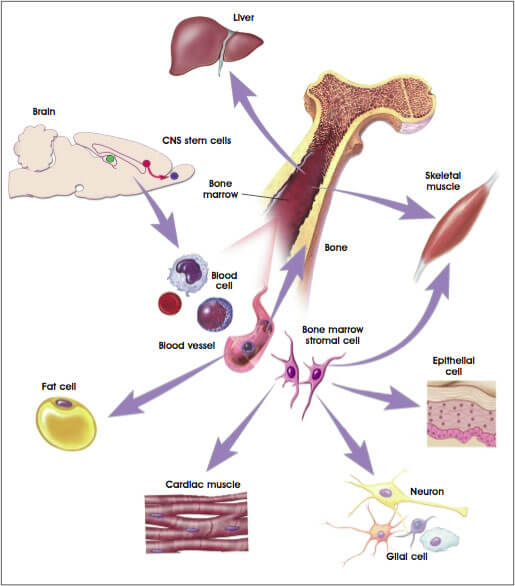
Figure: Preliminary Evidence of Plasticity Among Nonhuman Adult Stem Cells. Image Source: NIH Stem Cell Information.
3. Induced pluripotent stem cells (iPSCs)
- The limitations in adult stem cells led to the creation of novel pluripotent cells termed induced pluripotent cells from the adult cells by the process of reprogramming the genes.
- Induced pluripotent stem cells are formed when the adult cells are cultured with embryonic stem cells where a fusion of these two cells forms new cells with stem cell-like properties.
- Sometimes, other somatic cells can also be reprogrammed to acquire pluripotency.
- Induced pluripotent stem cells are similar to embryonic stem cells in that they can also be stimulated to differentiate into different cell types.
- However, they are different from embryonic stem cells in the level of gene expression and the condition of the chromatin of the cells.
- These cells are of significant importance as they can be used in therapeutic medicine where doctors will be able to generate cells of practically all organs of the body for each patient.
- Besides, they also prevent the use of more embryonic stem cells which might cause ethical issues.
- It also helps to study new genetic diseases by generating induced pluripotent stem cells from their adult or somatic cells.
- Induced stem cells of the heart and the eyes can be used in the transplantation of the cells during severe heart and eye-related diseases.
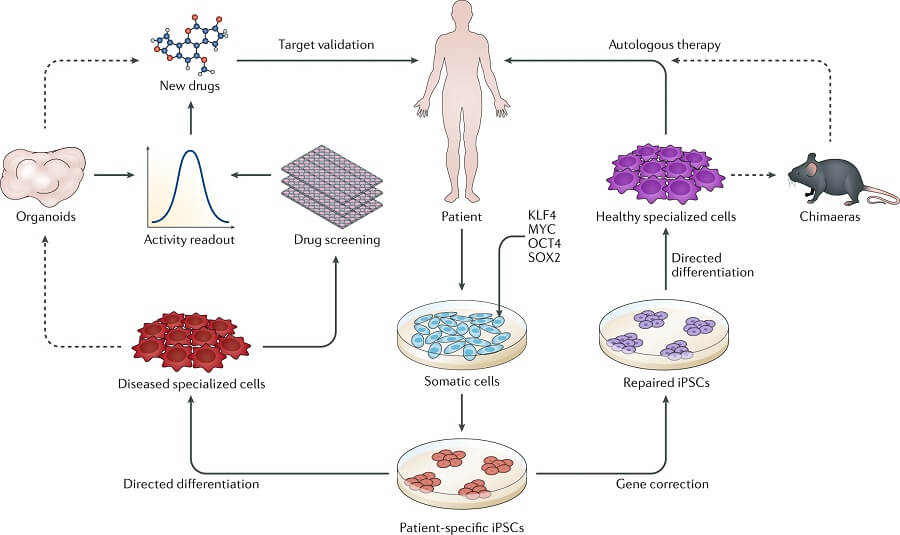
Figure: Progress in therapies based on iPSCs. Image Source: Nature Reviews Genetics (R. Grant Rowe & George Q. Daley).
4. Perinatal stem cells
- Perinatal stem cells are a type of intermediate cells carrying the characteristics of both embryonic stem cells and adult stem cells. They are derived from extra-embryonic cells of the fetal membrane, umbilical cord, and amniotic fluid.
- Prenatal stem cells are known to possess immune-privileged characteristics, as well as broad multipotent plasticity.
- Also, these cells, simply isolated from extraembryonic tissues that are typically discarded after birth, effectively avoid ethical issue involvement.
- These cells are active, non-tumorigenic, and are multipotent that can differentiate into cells of the endothelium, hepatic, adipose, and even neural tissues.
- The cells obtained from fetal membranes are, although not immortal, have a high degree of division and potency.
- Perinatal stem cells also have research and therapeutic applications in the treatment of renal disease, cardiac disease, inflammatory disease, bone regeneration, and the treatment of spinal cord injury.
- As a result of these applications, perinatal stem cells have been cultured artificially to obtain a large number of these cells.
5. Mesenchymal stem cells (MSCs)
- Mesenchymal stem cells are a type of adult stem cell or somatic stem cell mostly found in the tissues of muscles, liver, and bone marrow.
- Human MSCs (hMSCs) are the multipotent stem cells with the capacity to differentiate into mesodermal cell lines such as osteocytes, adipocytes, and chondrocytes as well ectodermal (neurocytes) and endodermal cell lines (hepatocytes).
- The most common type of mesenchymal stem cells is the one in the bone marrow where they differentiate to form the cells of the skeletal system, including bones and cartilages.
- Mesenchymal stem cells are found not only in fetal tissues but also in many adult tissues.
- These are mostly present in small quantities but are important as they create a niche for the survival of blood stem cells in the bone marrow.
- Mesenchymal stem cells can be isolated comparatively easily and also produce a higher yield than other stem cells which makes them useful in cell growth, cell differentiation, and restoration of tissues under severe immunological conditions.
- Furthermore, MSCs have immunomodulatory features as they secrete cytokines and immune-receptors, which regulate the microenvironment in the host tissue.
- The potential to produce cells of different cell lines, immunomodulation, and secretion of anti-inflammatory molecules makes this stem cell a useful tool in the treatment of chronic diseases.
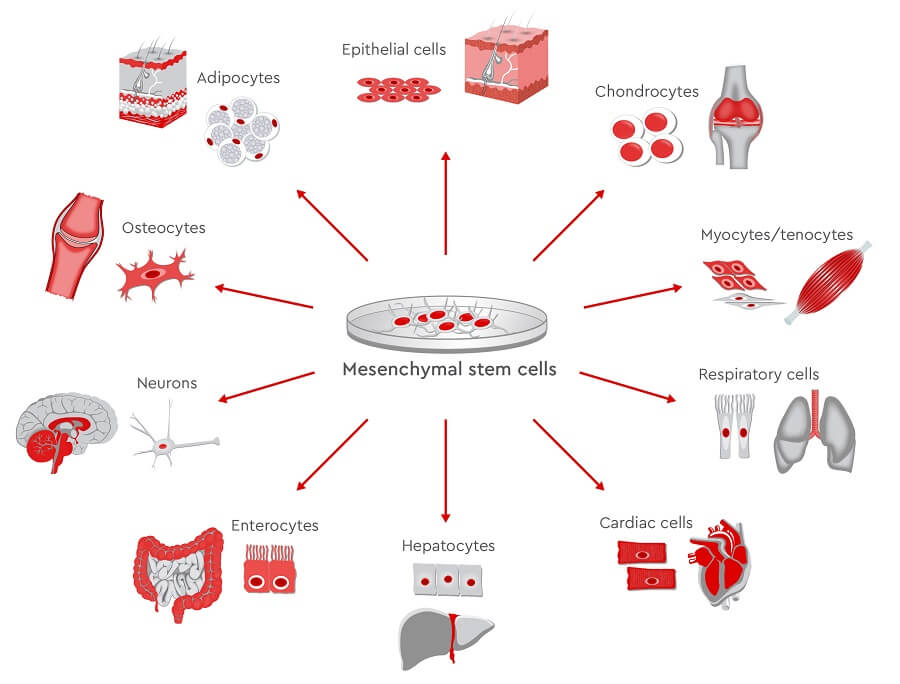
Figure: Mesenchymal stem cells (MSCs). Image Source: PromoCell GmbH.
Stem cell research with examples
- Stem cell research is an area of research that studies the properties of stem cells and their potential in medicine and therapeutical applications.
- This field of research has been of great interest to researchers to understand the properties of these cells to use them for medical purposes eventually.
- The studies related to these cells also helps in understanding the healthy and diseased body’s development and homeostasis.
- However, stem cell research has come under some controversy due to the ethical problems associated with how the stem cells are obtained.
- It is known that while obtaining the stem cells from an embryo, the embryo, in the end, is discarded, which raises ethical issues.
- However, due to the discovery and use of adult stem cells and induced pluripotent stem cells, the use of embryonic stem cells has decreased and so has the ethical issues.
Some of the common and well-known examples of stem cell research are:
1. The process of cell differentiation
- One of the most important examples of stem cell research is in the studies conducted to learn how undifferentiated stem cells develop and divide into specialized cells.
- Many studies are also involved in the process of control of the differentiation of stem cells.
- Over the years, many researchers and scientists are known to work on methods to manipulate the process of stem cell differentiation to produce specialized cells.
2. Stem cell-based therapies
- Studies related to control stem cell differentiation have also been performed so that they can be used to treat certain diseases.
- One example of this is the transformation of stem cells to differentiate into insulin-producing cells so that such cells can be transplanted to patients with type-1 diabetes.
- Several other projects aiming at different diseases and conditions are also being conducted.
3. Stem cells to test new drugs
- Stem cells cultured in laboratories are used in the testing of new drugs to avoid their use on human cells.
- This is one of the novel research areas related to stem cells.
Application/ Uses of Stem cell Research
Stem cell research has been used in various areas because of their properties. Some of the common applications of stem cells research include;
- Stem cell research has been used in the field of regenerative medicine, which deals with the restoration of tissues or organs in the patient suffering from severe injuries or some chronic disease.
- The progress made in the field of stem cell research has laid the foundation for other cell-based therapies of disease that cannot be cured with conventional medicines.
- Studies related to the human stem cell research has enormous potential for contributing to our understanding of fundamental human biology.
- Many years of research on stem cells has made it possible to transplant hematopoietic stem cells to the patients after the cancer treatments.
- Stem cell research has also been used for the testing of new drugs before they can be tested in animals or humans.
- Cultured stem cells are used for the transplant of cells in the case of various diseases like bone marrow for leukemia, nerve cells for Parkinson’s and Alzheimer’s disease, heart muscle for heart disease, and pancreatic islets for diabetes.
Limitations/ Challenges of Stem cell Research
Because of different ethical and other issues related to stem cell research, there are some limitations or challenges of stem cell research. Some of these are:
- The most crucial challenge to stem cell research is the ethical issue related to the use of embryonic stem cells. There are even political and religious obstructions to stem cell research due to these issues.
- The source of some stem cell lines might have mutations which increase the chances of mutations in the transplants.
- It is also difficult to transplant the stem cells produced in the laboratories to the target cells.
- Embryonic stem cells also do not permanently renew themselves in vivo, but instead, differentiate soon into different lineage progenitor cells of the three embryonic germ layers.
- Self-renewal of these cells can be achieved in vitro under artificial conditions, which inhibit their differentiation.
- It is also challenging to obtain a sufficient amount of stem cells with the ability to differentiate into the desired cell type.
- The differentiation of embryonic, as well as adult stem cells, even if guided by the addition of differentiation factors, inevitably involves a certain amount of spontaneous differentiation into various cell types
- Additionally, the differentiation is not synchronizable yet, leading to a mixture of cells in various stages of development.
Stem Cell lines
- A stem cell line is a group of certain stem cells that are cultured in vitro so that they can be propagated indefinitely for various purposes.
- The source of these cell lines is either humans or animals where these are either embryonic stem cells, adult stem cells, or induced stem cells.
- Stem cell lines are extensively used for genetic research and regenerative medicine purposes.
- The ability to renew themselves allows them to multiply to an indefinite state, which makes them very valuable.
- The stem cell lines retain their original genetic properties even after developing the ability to divide indefinitely.
- There are three types of stem cell lines depending on the source of the stem cells; embryonic stem cell lines, adult stem cell lines, and induced stem cell lines.
- The adult stem cell lines are not as effective in dividing to produce differentiated cells as the embryonic cell lines.
- The induced stem cell lines, however, can self-renew indefinitely in vitro while maintaining the ability to differentiate into derivatives of all three germ layers.
- The studies related to these cell lines are beneficial for understanding the differentiation and function of human tissues, for a drug screen and toxicity testing, and for cellular transplantation therapies.
Stem Cell Therapy
- Stem cell therapy, also known as regenerative medicine, is one of the applications of stem cells that promote the repair of dysfunctional and injured tissues and their derivatives.
- Pluripotent stem cells are not often used therapeutically in humans because some of these cells might result in the undesirable formation of unusual solid tumors, called teratomas.
- In animals, however, it has been used to treat spinal injuries and visual impairment.
- Multipotent stem cells, on the other hand, harvested from bone marrow have been used since the 1960s to treat leukemia, myeloma, and lymphoma.
- The use of mesenchymal stem cells in the ability to form whole joints might be beneficial for other diseases as well.
- It is also better to use multipotent stem cells in the place of pluripotent cells as the multipotent stem cells would prevent the rejection of transplants by the body’s immune system.
- Stem cell therapy thus is an excellent avenue for the improvement in the treatment facilities and methods of various chronic diseases.
- However, much still needs to be learned about their biology, manipulation, and safety before their full therapeutic potential can be achieved.
Video: The Promise of Stem Cell Therapy | Neil Neimark, MD | TEDx

References and Sources
- Mescher AL (2016). Basic Histology. Fourteenth Edition. McGraw-Hill Education.
- van der Sanden, B., Dhobb, M., Berger, F., & Wion, D. (2010). Optimizing stem cell culture. Journal of cellular biochemistry, 111(4), 801–807. https://doi.org/10.1002/jcb.22847
- Hongxiang Hui, Yongming Tang, Min Hu and Xiaoning Zhao (August 23rd 2011). Stem Cells: General Features and Characteristics, Stem Cells in Clinic and Research, Ali Gholamrezanezhad, IntechOpen, DOI: 10.5772/23755. Available from: https://www.intechopen.com/books/stem-cells-in-clinic-and-research/stem-cells-general-features-and-characteristics
- Kruse, S. Danner and D. H. Rapoport (2008). Current Stem Cell Technology: Limitations and Realistic Expectations. Eng. Life Sci. 2008, 8, No. 1, 13–18.
- Yu, J., & Thomson, J. A. (2008). Pluripotent stem cell lines. Genes & development, 22(15), 1987–1997. https://doi.org/10.1101/gad.1689808
- Biehl, J. K., & Russell, B. (2009). Introduction to stem cell therapy. The Journal of cardiovascular nursing, 24(2), 98–105. https://doi.org/10.1097/JCN.0b013e318197a6a5
- Mahla R. S. (2016). Stem Cells Applications in Regenerative Medicine and Disease Therapeutics. International Journal of cell biology, 2016, 6940283. https://doi.org/10.1155/2016/6940283
- Ullah, I., Subbarao, R. B., & Rho, G. J. (2015). Human mesenchymal stem cells – current trends and future prospective. Bioscience reports, 35(2), e00191. https://doi.org/10.1042/BSR20150025
- Si, J. W., Wang, X. D., & Shen, S. G. (2015). Perinatal stem cells: A promising cell resource for tissue engineering of craniofacial bone. World journal of stem cells, 7(1), 149–159. https://doi.org/10.4252/wjsc.v7.i1.149
- https://www.healthline.com/health/stem-cell-research#research
- https://www.nature.com/articles/stemcells.2007.17
- https://www.genetargeting.com/stem-cell/what-is-a-stem-cell-line/
- https://www.britannica.com/science/stem-cell

Thank you very much for this information.
I want to relate stem cell with muscular dystroph and austim and I want to learn the technique how to make stem cell from placenta and work autologous with adipose tissue make stromal vascular fraction
We must related stem cell to octopus and star fish..
Gud info and well explained